How many national parks and resorts one country can have? Looking at Thailand – a lot. This year finalist have shown great variety of natural parks.
Tham Sakoen National Park
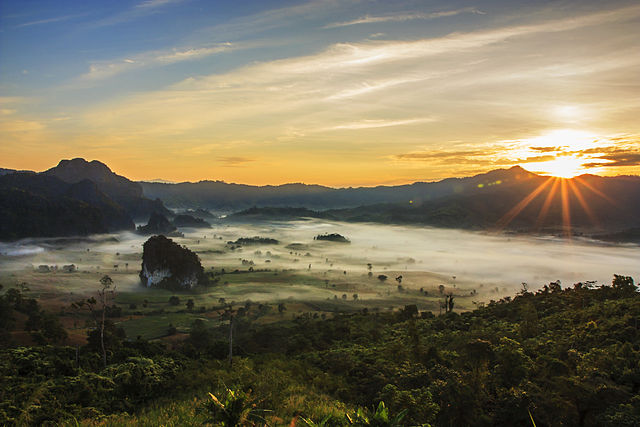
Tham Sakoen national park is located in Pa Namyoaw and Pa Namsuad forest reserves in Song Kawae district in the northern part of Nan province, close to Laos. The 448 square kilometers park is comprised of north-south rugged mountains that cross the border between Laos and Thailand. The elevation ranges from 300 to 1752 meters above the sea level, the highest peak being Doi Jee at 1752 meters. The mountains are the head waters of Lamnam Yom and Lamnam Nan, two important rivers of the country.
Khun Chae National Park

Khun Chae National Park is a national park in Chiang Rai Province, Thailand. This rugged park is home to high mountains and waterfalls.
Khun Chae National Park is located about 100 kilometres (60 mi) northeast of Chiang Mai in the Wiang Pa Pao district of Chiang Rai Province. The park’s area is 270 square kilometres (100 sq mi). Khun Chae Park is located in the Khun Tan Range and is home to the range’s highest peak, Doi Lang Ka at 2,031 metres (6,660 ft). The park adjoins two other national parks: Chae Son National Park and Mae Takhrai National Park.
Thong Pha Phum National Park

Thong Pha Phum National Park is a national park in Kanchanaburi Province, Thailand. The park, located on the border with Burma, is part of the Western Forest Complex protected area.
Khao Yai National Park
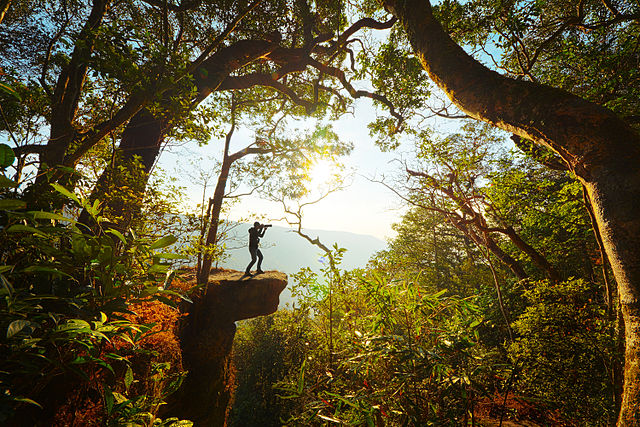
Khao Yai National Park is in the western part of the Sankamphaeng Mountain Range, at the southwestern boundary of theKhorat Plateau. The highest mountain in the area of the park is 1,351 m high Khao Rom.
This park lies largely in Nakhon Ratchasima Province (Khorat), but also includes parts of Saraburi, Prachinburi, and Nakhon Nayok Provinces.
The park is the third largest in Thailand. It covers an area of 300 square kilometers, including evergreen forests and grasslands. Its altitude mostly ranges from 400–1,000 m above sea level. There are 3,000 species of plants, 320 species of birds like red junglefowl and coral-billed ground cuckoo, and 66 species of mammals, including Asian black bear, Asian elephant, gaur,gibbon, Indian sambar deer, pig-tailed macaque, Indian muntjac, dhole, and wild pig.
Recent wildlife studies show that animal ranges, particularly the few resident tigers, are impacted by human activity near the center of the park. This study has not deflected the government’s call for private lodging concessions within the park itself.
Elephant
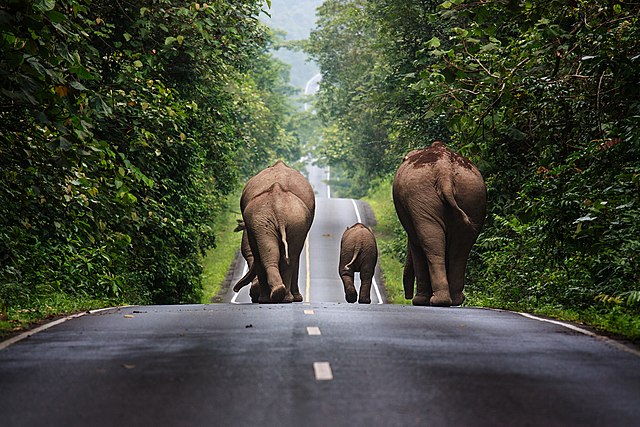
Elephants are large mammals of the family Elephantidae and the order Proboscidea. Two species are traditionally recognised, the African elephant (Loxodonta africana) and the Asian elephant (Elephas maximus), although some evidence suggests that African bush elephantsand African forest elephants are separate species (L. africana and L. cyclotis respectively). Elephants are scattered throughout sub-Saharan Africa, South Asia, and Southeast Asia. Elephantidae is the only surviving family of the order Proboscidea; other, now extinct, members of the order include deinotheres, gomphotheres, mammoths, and mastodons. Male African elephants are the largest extantterrestrial animals and can reach a height of 4 m (13 ft) and weigh 7,000 kg (15,000 lb). All elephants have several distinctive features the most notable of which is a long trunk or proboscis, used for many purposes, particularly breathing, lifting water and grasping objects. Theirincisors grow into tusks, which can serve as weapons and as tools for moving objects and digging. Elephants’ large ear flaps help to control their body temperature. Their pillar-like legs can carry their great weight. African elephants have larger ears and concave backs while Asian elephants have smaller ears and convex or level backs.
Khao Laem Ya – Mu Ko Samet National Park

Khao Laem Ya – Mu Ko Samet is a Thai marine national park in the Gulf of Thailand off the coastline of the Thai province of Rayong, approximately 180 km southeast of Bangkok. In 1981, the Royal Forest Department of the Thai Government declared the archipelago of Ko Samet, along with nine other small islands, the headland of Khao Laem Ya, and the 11 kilometre Mae Rampeung Beach to be a national park, and thus these areas are under the jurisdiction of the national parks department. In August, 2013 more than 500 national park officials were deployed to destroy three resorts – Muk Samet, Unseen, and Ploy Samet – which had been built illegally in the Khao Leam Ya-Mu Ko Samet National Park.
Phu Hin Rong Kla National Park

Phu Hin Rong Kla National Park is a national park located in the Loei, Phitsanulok and Phetchabun Provinces of Thailand. Theprotected area is located in the forested mountains of the Luang Prabang Range close to the border with Laos and is part of theLuang Prabang montane rain forests ecoregion.
Khlong Lan National Park

Khlong Lan National Park is situated in the Dawna Mountain Range.
This park lies in Khlong Lan and Mueang Kamphaeng Phet districts of Kamphaeng Phet Province, the West of Thailand.
The park is rugged and hilly along the Dawna Range, and is covered by fertile forest. Each mountain connects to Khun Khlong Lan, the highest peak at 1,439 metres (4,721 ft) above sea level. It’s the origin of Khlong Khlung and Khlong Suan Mak, the tributaries of the Ping River. The famous places in the park are Khlong Lan and Khlong Nam Lai Waterfalls.
Similan Islands
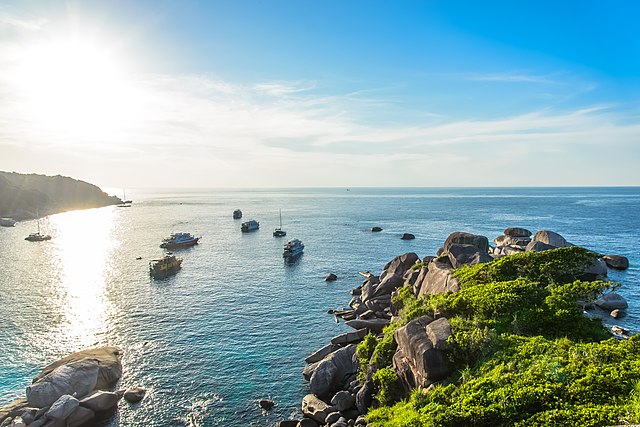
The Similan Islands is a group of islands in the Andaman Sea off the coast of, and part of, Phang Nga Province, southern Thailand. It is a national park which was established in 1982.
Similan Islands National Park was established after a one-year exploration by the forestry department. The park is an archipelagoconsisting of nine islands named Ko Bon, Ko Bayu, Ko Similan, Ko Payu, Ko Miang (two adjoining islands), Ko Payan, Ko Payang, and Ko Huyong. Recently, the park was expanded to include two remote islands named Ko Bon and Ko Tachai. The Similans are situated 70 kilometres from Phang Nga town. “Similan” is a Yawi word which means “nine”.
Khuean Srinagarindra National Park
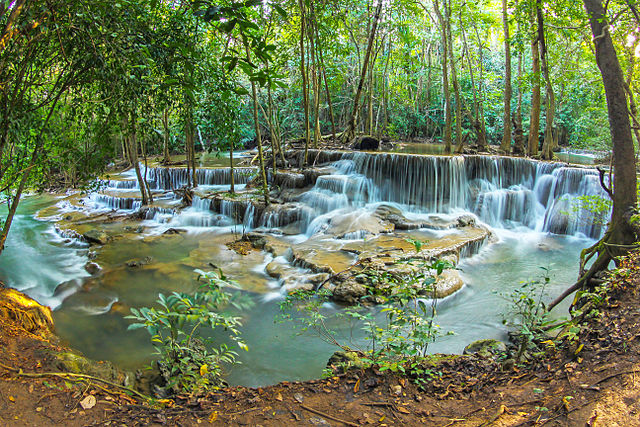
Khuean Srinagarindra National Park, also known as Si Nakharin National Park, is anational park in Kanchanaburi Province, Thailand. The park, centred on the Srinagarind Reservoir, is part of the Western Forest Complex protected area.
References:
- http://www.trekthailand.net/north55/
- https://en.wikipedia.org/wiki/Khun_Chae_National_Park
- https://en.wikipedia.org/wiki/Thong_Pha_Phum_National_Park
- https://en.wikipedia.org/wiki/Khao_Yai_National_Park
- https://en.wikipedia.org/wiki/Elephant
- https://en.wikipedia.org/wiki/Khao_Laem_Ya_%E2%80%93_Mu_Ko_Samet_National_Park
- https://en.wikipedia.org/wiki/Phu_Hin_Rong_Kla_National_Park
- https://en.wikipedia.org/wiki/Khlong_Lan_National_Park
- https://en.wikipedia.org/wiki/Similan_Islands
- https://en.wikipedia.org/wiki/Khuean_Srinagarindra_National_Park

I’d like to contact Khunkay if possible. Would anyone have contact info for this gifted photographer?
Thanks so much!
Ricardo Villa – Colorado, USA
It is possible to leave a message on user page on Commons.